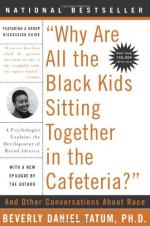
|
| Name: _________________________ | Period: ___________________ |
This quiz consists of 5 multiple choice and 5 short answer questions through Part IV, Beyond Black and White, Chapter 8, Critical Issues in Latino, American Indian, and Asian Pacific American Identity Development.
Multiple Choice Questions
1. In Part II, Understanding Blackness in a White Context, Chapter 3, Tatum writes that she often opens race seminars with adults by asking them about what?
(a) The most recent occurance of racism they have seen.
(b) Their first race-related memory.
(c) If they have ever been a victim of racism.
(d) The degree of their parents' racism.
2. What was the ratio of black men to women at the university Tatum attended in Part II, Understanding Blackness in a White Context, Chapter 5, Racial Identity in Adulthood?
(a) 7 to 1.
(b) 5 to 1.
(c) 13 to 8.
(d) 20 to 7.
3. Tatum writes in Part II, Understanding Blackness in a White Context, Chapter 3 that often black children express self-rejection and internalized __________.
(a) Financial prejudice.
(b) Educational prejudice.
(c) Skin prejudice.
(d) Language prejudice.
4. What refers to an affective state of consciousness in which joy, sorrow, fear, hate, or the like, is experienced, as distinguished from cognitive and volitional states of consciousness?
(a) Internalization.
(b) Immersion.
(c) Hostility.
(d) Emotion.
5. What concept defined by the author holds the extended family as a reference group for social support?
(a) Matrilineality.
(b) Miscegenation.
(c) Familism.
(d) Marginalization.
Short Answer Questions
1. What refers to a similarity between like features of two things, on which a comparison may be based?
2. Puerto Rico is Spanish for what phrase?
3. Tatum writes in Part II, Understanding Blackness in a White Context, Chapter 3 that children can notice race as young as how old?
4. What refers to opposition or resistance to an idea, plan, project, etc.?
5. Why did Tatum's son assume a black boy was running down the street in an example given in Part II, Understanding Blackness in a White Context, Chapter 3?
|
This section contains 294 words (approx. 1 page at 300 words per page) |

|




